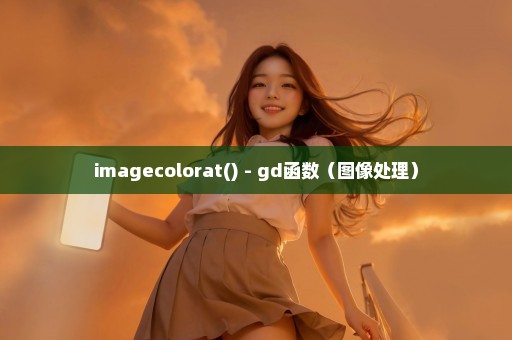imagecolorat() - gd函数(图像处理)
imagecolorat()
(PHP 4, PHP 5, PHP 7)
取得某像素的颜色索引值
说明
imagecolorat(resource $image,int $x,int $y): int返回$image所指定的图形中指定位置像素的颜色索引值。

如果 PHP 编译时加上了 GD 库 2.0 或更高的版本并且图像是真彩色图像,则本函数以整数返回该点的 RGB 值。用移位加掩码来取得红,绿,蓝各自成分的值:
取得各自的 RGB 值
参见imagecolorset()和imagecolorsforindex()。
I made a function that calculates the average color of a given image resource and returns it in "#rrggbb" format (hex):
function average($img) {
$w = imagesx($img);
$h = imagesy($img);
$r = $g = $b = 0;
for($y = 0; $y > 16;
$g += $rgb >> 8 & 255;
$b += $rgb & 255;
}
}
$pxls = $w * $h;
$r = dechex(round($r / $pxls));
$g = dechex(round($g / $pxls));
$b = dechex(round($b / $pxls));
if(strlen($r) As creamdog noted before, the alpha channel IS available from this function! (The manual should probably be updated to include this!)
$rgba = imagecolorat($im,$x,$y);
$alpha = ($rgba & 0x7F000000) >> 24;
$alpha will then contain the TRANSPARENCY (NOT OPACITY) level. So 127, the max, would be completely transparent, and 0 would be completely opaque.
Using this information, it is possible to write a dithering png-to-gif function like the completely working simple one below:
trimImage ( resource $image , int $colour , int $tolerance )
trimImage() will return top-most, right-most, bottom-most and left-most positions of wanted pixels for an image (i.e. find minimum image area so you can then trim given colour from the outer edges of an image).
Parameters
image
An image resource, returned by one of the image creation functions, such as imagecreatetruecolor().
colour
colour to be 'trimmed'. Allowable range 0 (black) to 255 (white). if null (or outside 0 - 255) will use top/left corner colour as default.
tolerance
Acceptable range +- from colour. 0 (trim only exact colour) to 255 (trim all colours).
Return Values
Returns an array of outermost pixels which are outside the tolerance range from colour.
array( int $top, int $right, int $bottom, int $left )
Example (and actual function)
Look mom, no tables :)
I made some changes to the code from 'hazard AT krankteil DOTTILLYDO de' so the function would output a div that displays the image.
As for the size of the outputted file I can say the original png file was lots smaller, but maybe its a nice feature for small buttons or such.
The way you can use it is the same as the code from 'hazard AT krankteil DOTTILLYDO de'.
litle note: each div contains a bogus image. When this is not in IE will screw up the output.
This improves upon to my previous function (which only really worked on a few greyscale colours). Colour should now be a hexadecimal colour value. Colour and tolerance are now optional parameters.
trimImage ( resource $image [, str $colour [, int $tolerance]] )
trimImage() will return top-most, right-most, bottom-most and left-most positions of wanted pixels for an image (i.e. find minimum image area so you can then trim given colour from the outer edges of an image).
Parameters
image
An image resource, returned by one of the image creation functions, such as imagecreatetruecolor().
colour
Hexadecimal value of colour to be 'trimmed'. If omitted the top/left corner colour will be used as default.
tolerance
Acceptable range +- from colour. Allowable range 0 to 255. If omitted 10 will be used as default.
Return Values
Returns an array of outermost pixels which are beyond the tolerance range from colour.
array( int $top, int $right, int $bottom, int $left )
function trimImage($im,$c=null,$t=10) {
// if hex colour ($c) exists attempt to convert to decimal
if ($c) $rgb = @hexdec($c);
// if hexdec failed to get a value between black (0) and white (16777215)
// grab the colour from the top left corner (2 pixels in to avoid messy edges)
if (!is_numeric($rgb) || $rgb 16777215) $rgb = imagecolorat($im, 2, 2);
// split $rgb into red, green and blue
$r = ($rgb >> 16) & 0xFF;
$g = ($rgb >> 8) & 0xFF;
$b = $rgb & 0xFF;
// make sure tolerance ($t) is a number between 0 - 255
if (!is_numeric($t) || $t 255) $t = 255;
$w = imagesx($im); $h = imagesy($im); // image width and height
for($x = 0; $x > 16) & 0xFF;
$grn = ($rgb >> 8) & 0xFF;
$blu = $rgb & 0xFF;
if (
$red $r+$t || // not trim red (nor within tolerance)
$grn $g+$t || // not trim green (nor within tolerance)
$blu $b+$t // not trim blue (nor within tolerance)
) {
$y_axis[$y] = $y; $x_axis[$x] = $x; // wanted pixel coordinates stored
}
}
}
if (!$y_axis) $y_axis = $x_axis = array(0); // avoid errors if all pixels are trimmed
// sort so first and last occurances are at start and end
sort($y_axis); sort($x_axis);
$t = array_shift($y_axis); // first wanted pixel on Y axis (top)
$r = array_pop($x_axis); // last wanted pixel on X axis (right)
$b = array_pop($y_axis); // last wanted pixel on Y axis (bottom)
$l = array_shift($x_axis); // first wanted pixel on X axis (left)
return array($t,$r,$b,$l);
}imagecolorat() works differently for png's with true color and for paletted png's - for true color it returns value of color, for paletted it returns index number and you have to use imagecolorsforindex() to get rgb color value.
In GD 2.x there is support for true color images complete with an alpha channel. GD 2.x has a 7-bit (0-127) alpha channel.
While most people are used to an 8-bit (0-255) alpha channel, it is actually quite handy that GD's is 7-bit (0-127). Each pixel is represented by a 32-bit signed integer, with the four 8-bit bytes arranged like this:
High Byte Low Byte
{Alpha Channel} {Red} {Green} {Blue}
For a signed integer, the leftmost bit, or the highest bit, is used to indicate whether the value is negative, thus leaving only 31 bits of actual information. PHP's default integer value is a signed long into which we can store a single GD palette entry. Whether that integer is positive or negative tells us whether antialiasing is enabled for that palette entry.Here is a contribution for change tint.
function colorize($path_image, $red, $green, $blue)
{
$im = imagecreatefrompng($path_image);
$pixel = array();
$n_im = imagecreatetruecolor(imagesx($im),imagesy($im));
$fond = imagecolorallocatealpha($n_im, 255, 255, 255, 0);
imagefill($n_im, 0, 0, $fond);
for($y=0;$ypx; height: px; position: absolute; display: block;} 鹏仔微信 15129739599 鹏仔QQ344225443 鹏仔前端 pjxi.com 共享博客 sharedbk.com
免责声明:我们致力于保护作者版权,注重分享,当前被刊用文章因无法核实真实出处,未能及时与作者取得联系,或有版权异议的,请联系管理员,我们会立即处理! 部分文章是来自自研大数据AI进行生成,内容摘自(百度百科,百度知道,头条百科,中国民法典,刑法,牛津词典,新华词典,汉语词典,国家院校,科普平台)等数据,内容仅供学习参考,不准确地方联系删除处理!邮箱:344225443@qq.com)
图片声明:本站部分配图来自网络。本站只作为美观性配图使用,无任何非法侵犯第三方意图,一切解释权归图片著作权方,本站不承担任何责任。如有恶意碰瓷者,必当奉陪到底严惩不贷!
内容声明:本文中引用的各种信息及资料(包括但不限于文字、数据、图表及超链接等)均来源于该信息及资料的相关主体(包括但不限于公司、媒体、协会等机构)的官方网站或公开发表的信息。部分内容参考包括:(百度百科,百度知道,头条百科,中国民法典,刑法,牛津词典,新华词典,汉语词典,国家院校,科普平台)等数据,内容仅供参考使用,不准确地方联系删除处理!本站为非盈利性质站点,本着为中国教育事业出一份力,发布内容不收取任何费用也不接任何广告!)
 百科狗
百科狗



